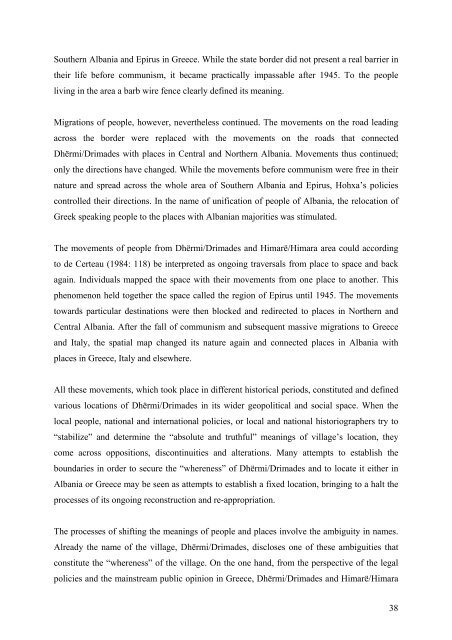university of nova gorica graduate school contested spaces and ...
university of nova gorica graduate school contested spaces and ...
university of nova gorica graduate school contested spaces and ...
You also want an ePaper? Increase the reach of your titles
YUMPU automatically turns print PDFs into web optimized ePapers that Google loves.
Southern Albania <strong>and</strong> Epirus in Greece. While the state border did not present a real barrier in<br />
their life before communism, it became practically impassable after 1945. To the people<br />
living in the area a barb wire fence clearly defined its meaning.<br />
Migrations <strong>of</strong> people, however, nevertheless continued. The movements on the road leading<br />
across the border were replaced with the movements on the roads that connected<br />
Dhërmi/Drimades with places in Central <strong>and</strong> Northern Albania. Movements thus continued;<br />
only the directions have changed. While the movements before communism were free in their<br />
nature <strong>and</strong> spread across the whole area <strong>of</strong> Southern Albania <strong>and</strong> Epirus, Hohxa’s policies<br />
controlled their directions. In the name <strong>of</strong> unification <strong>of</strong> people <strong>of</strong> Albania, the relocation <strong>of</strong><br />
Greek speaking people to the places with Albanian majorities was stimulated.<br />
The movements <strong>of</strong> people from Dhërmi/Drimades <strong>and</strong> Himarë/Himara area could according<br />
to de Certeau (1984: 118) be interpreted as ongoing traversals from place to space <strong>and</strong> back<br />
again. Individuals mapped the space with their movements from one place to another. This<br />
phenomenon held together the space called the region <strong>of</strong> Epirus until 1945. The movements<br />
towards particular destinations were then blocked <strong>and</strong> redirected to places in Northern <strong>and</strong><br />
Central Albania. After the fall <strong>of</strong> communism <strong>and</strong> subsequent massive migrations to Greece<br />
<strong>and</strong> Italy, the spatial map changed its nature again <strong>and</strong> connected places in Albania with<br />
places in Greece, Italy <strong>and</strong> elsewhere.<br />
All these movements, which took place in different historical periods, constituted <strong>and</strong> defined<br />
various locations <strong>of</strong> Dhërmi/Drimades in its wider geopolitical <strong>and</strong> social space. When the<br />
local people, national <strong>and</strong> international policies, or local <strong>and</strong> national historiographers try to<br />
“stabilize” <strong>and</strong> determine the “absolute <strong>and</strong> truthful” meanings <strong>of</strong> village’s location, they<br />
come across oppositions, discontinuities <strong>and</strong> alterations. Many attempts to establish the<br />
boundaries in order to secure the “whereness” <strong>of</strong> Dhërmi/Drimades <strong>and</strong> to locate it either in<br />
Albania or Greece may be seen as attempts to establish a fixed location, bringing to a halt the<br />
processes <strong>of</strong> its ongoing reconstruction <strong>and</strong> re-appropriation.<br />
The processes <strong>of</strong> shifting the meanings <strong>of</strong> people <strong>and</strong> places involve the ambiguity in names.<br />
Already the name <strong>of</strong> the village, Dhërmi/Drimades, discloses one <strong>of</strong> these ambiguities that<br />
constitute the “whereness” <strong>of</strong> the village. On the one h<strong>and</strong>, from the perspective <strong>of</strong> the legal<br />
policies <strong>and</strong> the mainstream public opinion in Greece, Dhërmi/Drimades <strong>and</strong> Himarë/Himara<br />
38

















